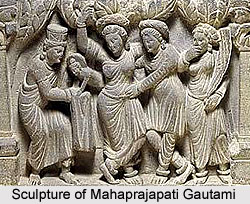 The first woman whom Gautama Buddha permitted to join the Sangha was Mahapajapati Gautami. After the death of Mayadevi, Buddha`s mother, it was Mahapajapati Gautami who brought up young Siddhartha. She was a maternal figure for Buddha. The lady was born in Devadaha, Nepal. Today one can find this place in Southern Nepal.
The first woman whom Gautama Buddha permitted to join the Sangha was Mahapajapati Gautami. After the death of Mayadevi, Buddha`s mother, it was Mahapajapati Gautami who brought up young Siddhartha. She was a maternal figure for Buddha. The lady was born in Devadaha, Nepal. Today one can find this place in Southern Nepal.
When Buddha`s mother died within seven days of giving birth to him. It was Prajapati who looked after him and nursed him. She too was married to King Suddhodana, Buddha`s father. According to legends she loved the child so much that her own children, Ananda and Sundari Nanda were brought up by nurses while she looked after Siddhartha.
When king Suddhodana passed away Mahapajapati Gautami decided to renounce the world. At this point of time Gautama Buddha was at Vaishali. She waited for his return so that she can seek his permission to join them. Pajapati was already a Sotapanna by then. The sages had earlier predicted that she would be the one who would compel Buddha to allow women to join his order. Her opportunity to join the order arrived when Buddha visited Kapilavastu to settle the disputes between Sakyas and Koliyas. These two clans were fighting on the issue that who had the right to take water from the Rohini River. After settling the matter Buddha preached Kalahaviv?da Sutta. This had such effect that 500 Sakya men joined the discipline. Pajapati and several other Sakya women too approached Buddha for joining him. Buddha, however, refused and proceeded to Vaishali.
The refusal could not spoil the spirit and determination of Mahapajapati Gautami. She arrived at Vaishali with her companions. They had cut their hair and clad in yellow robes they arrived where Buddha had been staying. Walking bare feet had wounded them badly. Buddha was yet not convinced that they could lead a life of a sage. Hence he refused once again. This time it was Ananda, his stepbrother, intervened and their request was granted. At last their persistence made them monastics. Buddha laid down before them eight strict conditions that they were supposed to follow for the rest of their lives. Later some confusion arose regarding the ordination of Pajapati. It was said that the ordination of Pajapati was not formally completed. The nuns refused to perform uposatha with her. Buddha came to her rescue and announced that he himself had performed the ceremony. This solved the matter once for and all. The upasampada of Mahapajapati Gautami comprised of complying to the 8 conditions laid down for the nuns.
After her ordination Prajapati worshipped Buddha. Buddha preached to her and gave her a subject for meditation. With meditation she developed insight and soon achieved arahantship. Her 500 companions attained arahantship only after listening to Nandakov?da Sutta. Mahaprajapati Gautami was declared rattannunam or "Chief of Those Who had Experience" by Gautama Buddha. This event took place at an assembly of nuns and monks in Jetavana. Soon after this at Vaishali Prajapati realized that her life is coming to an end. She took leave from Buddha, performed various miracles and died. According to legends her 500 companions also died with her. At the time of her death she was one hundred and twenty years old. The miracles that she performed were close to those of Buddha.
She set an example for women who wanted to join the Buddhist monastery. Her dedication and determination is unforgettable. That is the reason why she remains one of the greatest names in Buddhism till date.
According to legends Prajapati was reborn time and again. In the time of Padumuttara Buddha it is said that Prajapati was reborn and gained popularity. In this birth she belonged to Hamsavati region. She performed a number of miracles this time too and joined the nuns. After a few years she was again born in Benaras as a forewoman of slave girls. In this birth she served the Pacceka Buddhas. After this she was born to the family of weavers and again served the principles of Buddha.
Pajapati had a special place in Buddha`s life. One of the most probable reasons for this was because Mahapajapati Gautami was a mother to him. When she lay ill no monks visited to preach to her, as that was the rule. Buddha amended the rule and himself went there to preach to her.









